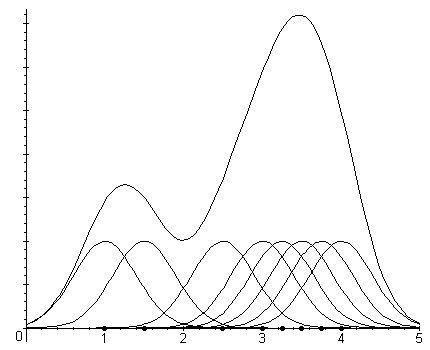![[CESCG logo]](../../CESCG/images/cescg98.small.gif)
Rázsó István Márk
rezso@inf.bme.huDepartment of Control Engineering and Information Technology
Technical University of Budapest
Budapest, Hungary
![[CESCG logo]](../../CESCG/images/cescg.small.gif)
![[CESCG logo]](../../CESCG/images/cescg98.small.gif)
|
Particle Tracing Methods in Photorealistic Image Synthesis
Rázsó István Márk rezso@inf.bme.huDepartment of Control Engineering and Information Technology Technical University of Budapest Budapest, Hungary |
![[CESCG logo]](../../CESCG/images/cescg.small.gif)
|
In these type of algorithms we use the previously generated hit points
on the surfaces with an associated incoming power. For these algorithms
we must store the power of the particle, the surface which the particle
hit and a local coordinate on the same surface.
We are interested in the diffuse radiance of a surface.
A Lambertian surface has a constant BRDF (![]() ) for all incoming/outgoing directions, where
) for all incoming/outgoing directions, where ![]() is
the reflectance. This implies, that a Lambertian surface will have a constant
surface radiance for all incoming/outgoing direction pairs. On a Lambertian
surface at
is
the reflectance. This implies, that a Lambertian surface will have a constant
surface radiance for all incoming/outgoing direction pairs. On a Lambertian
surface at ![]() coordinates,
we have a surface reflectance
coordinates,
we have a surface reflectance ![]() and
an irradiance
and
an irradiance ![]() .
The radiant exitance of the surface at is
.
The radiant exitance of the surface at is ![]() .
The radiance is
.
The radiance is ![]() ,
or it can be expressed like
,
or it can be expressed like ![]() .
This equation implies that we can store the irradiance and the reflectance
of the surface independently, and later reconstruct the radiance.
.
This equation implies that we can store the irradiance and the reflectance
of the surface independently, and later reconstruct the radiance.
At this point, we have to generate surface meshes
from the irradiance presented by the photon hits. This is a density estimation
problem, where we have non-uniform random samples. To estimate this photon
density, there are different classes of density estimation algorithms have
been used:

We have a list of hit points for each surface, and we have to estimate
the irradiance on the surface. The irradiance is represented by these hits,
where a finite amount of energy strikes an infinitely small area. In one
dimension the density function of the irradiance can be represented by
taking ![]() samples
(
samples
( ![]() ):
):



